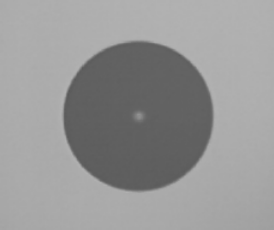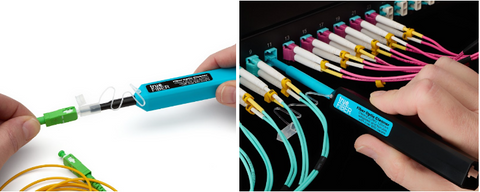Cleaning Fiber Optic End Faces: Contamination Sources and Cleaning Methods
Written by Ben Hamlitsch, trueCABLE Technical and Product Innovation Manager RCDD, FOI
An often overlooked item by people new to installing fiber optic cable runs is cleanliness. Fiber optic cleaning is essential for optimal fiber performance. Fiber optic cable runs are extremely susceptible to things that block light--especially at the very end of that run. In fact, that is the number one reason for failed or poorly performing fiber optic installations. Dirt, oil, fingerprints or a combination of these on the end face of the fiber will potentially ruin your day. To make matters worse, if one of these dirty end faces happens to be plugged into a female coupler or piece of active optical equipment it is actually possible to permanently damage the end face of the other fiber connection and even damage the optical transceiver that the fiber is connected to. This can become a costly problem if not properly inspected and cleaned to ensure cleanliness.
In this blog we will cover:
- What a clean vs contaminated fiber end face looks like
- How does contamination commonly occur?
- How to clean fiber optic connectors
- How to clean fiber cable
- Various methods used to clean fiber optic end faces
What Does Contamination Look Like?

The most common contaminants found on fiber end faces are fingerprints and just plain old dust. Both can and will block light transmission. Now, you might be thinking “how is that possible?” Consider that the core of the fiber optic cable in single mode fiber is 9 microns (you need a microscope to see it) and a piece of dust or even a fingerprint can easily block it.

Single mode (SMF) fiber core. 9 microns. Imagine the fingerprint contamination shown above on the top of that.
How Does Contamination Commonly Occur?
Fiber optic connector ferrule and end face contamination can occur for various reasons:
- Contamination from the manufacturing process at the factory during production, testing, or packaging
- Cross contamination from one component to another
- Dust in the air
- Lint from clothing
- Human skin cells
- Careless handling
It goes without saying that one should not assume that a connector ferrule or end face is clean, even with a new product right from the bag. The mere process of plugging and unplugging fiber optic connectors can introduce contamination as well. Fiber optic connectors have end caps and sometimes rubber plugs as well to keep contaminants from entering them.

Tips:
- Keep any protective covers on until you are in the process of cleaning them or plugging them in!
- Always use a “click cleaner” dedicated to the task immediately after removing any protective caps from BOTH mating connections but before plugging them in
- Clean connections before and during testing procedures
- Store and carry fiber optic connectors in the original packaging or container to minimize contamination
Various Methods Used to Clean Fiber Optic End Faces
There are various fiber optic cleaning kits that include the needed Fiber optic cleaning tools in order to get the job done. Fiber optic cleaning supplies often include a combination of Isopropyl alcohol (IPA) or other approved solvents for cleaning fiber optic connectors and end-faces. Pre-moistened wipes or cleaning pads saturated with cleaning fluids. Lint-free cleaning sticks or swabs designed specifically for fiber optic connectors. Lint-free cleaning cloths or wipes for cleaning connector housings and adapters.
Some methods of cleaning fiber optic ferrules and end faces are safer than others. The common methods are:
- Dry swabs or patches
- Wet swabs or patches
- Wet to dry pad method
- Dedicated mechanical push-activated cleaners (fiber cleaning pen)
Pure dry swabbing and pure wet swabbing are not recommended as issues can occur. Dry swabbing alone may scratch the end face of your fiber connector, and more often than not will actually generate a static charge that will attract contaminants right after swabbing. Wet swabbing alone can flood into the connector ferrule and cause cross contamination. The two most effective methods commonly used are the wet to dry pad (for extremely dirty end faces) and the dedicated mechanical push-activated cleaners.
Note: Do not use Isopropyl Alcohol (IPA) of any percentage for fiber cleaning. These chemicals may not be pure enough for the task due to buffering agents.
The wet to dry pad technique is to place a small amount of dedicated fiber optic cleaning solution on one side of a lint free pad (also dedicated to the task). Swipe from the wet side to the dry in one motion. Do not make circle “8” patterns.

Advantages to the wet/dry method shown above:
- Effective for extremely dirty end-faces (difficult to remove oils)
- Low risk of cross contamination
- Low risk of static charge build up on the fiber end face
Disadvantages to the wet/dry method:
- Requires multiple components (special cleaning cloths and approved solvents). Less portable.
- Requires a stable work surface to move from wet > dry
- Does not address bulkhead connectors / couplers

The second method is also highly recommended and can be used to clean bulkhead connectors / couplers as well as fiber patch connectors (male plug).
Advantages to mechanical “click” cleaner pens:
- Portable and versatile. Ability to reach into tight areas like high density patch panels as well as clean connector end faces.
- Each activation advances to a clean cleaning surface. It is not possible to accidentally reuse a dirty wipe with this process.
- Difficult to accidentally damage your connection points (unless you are being careless)
- Dry. No solvents are involved. The special fiber ribbon will not impart a static charge and the body of the cleaner is also anti-static.

Disadvantages to mechanical “click” cleaner pens:
- Not as cost effective as the wet to dry method. Good for 800 activations (typically) before it must be discarded and replaced with a completely new pen.
- Requires up to two pens, one for 2.50mm ferrules and one for 1.25mm ferrules, depending on what you need to clean. Often you will only require a single type, but requiring both types can occur in instances where older fiber optic installations are receiving incremental upgrades or if you install fiber optic cable for a living.
- Less effective for difficult to remove oil contamination
How to clean fiber optic cable
In order to clean fiber optic cable we use a slightly different method than what is used for connectors. This typically requires the wet method and the fiber is cleaned and prepared to be mechanical or fusion spliced. Before the cable is cleaved it is important to clean the stripped fiber strand to ensure any dirt or dust is not on the fiber strand before it is cleaved and spliced with a mechanical or fusion splice.

A good fiber optic cleaning system is to have both the wet to dry and click cleaning pen system available to you. Purchase and carry both methods in your fiber optic tool kit. Most of the time the mechanically activated pen style cleaner is more than sufficient and allows for rapid cleaning of connectors and couplers before actually plugging anything in. For really tough fingerprint oils or grease on the end face, the wet to dry method is often the only solution.
So, there you have it! Now you know why it is important to keep your end face clean and how to do it with minimal difficulty. With that, we will say…
HAPPY NETWORKING!
trueCABLE presents the information on our website, including the “Cable Academy” blog and live chat support, as a service to our customers and other visitors to our website subject to our website terms and conditions. While the information on this website is about data networking and electrical issues, it is not professional advice and any reliance on such material is at your own risk.






















































